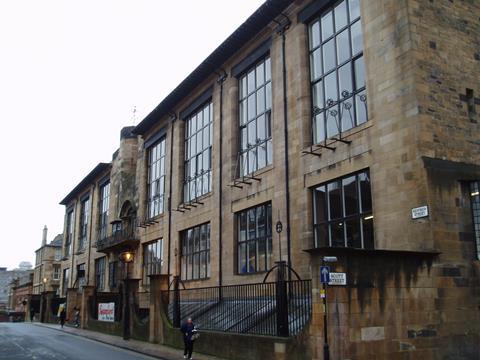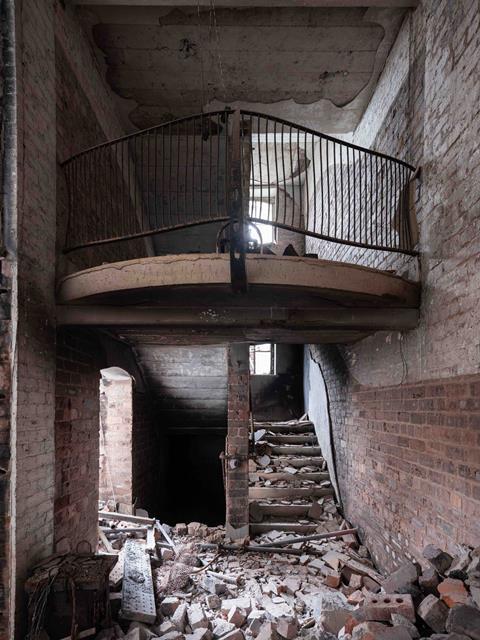Fire investigators unable to determine whether blaze was arson or accident despite three-year probe

Investigators have been unable to determine the cause of the blaze that destroyed Charles Rennie Mackintosh’s Glasgow School of Art building in 2018 during its restoration by Page\Park.
They said too much of the fabric – including the fire alarm control panel and CCTV hard drive – was consumed in the fire, the second to hit the grade A-listed building in four years.
GSA director Penny Macbeth said she and interim chair of governors Kristen Bennie “share the frustration that many will feel that the exact cause of the fire has not been identified”.
The Scottish Fire and Rescue Service (SFRS) published the findings of its detailed investigation yesterday.
Taking from the night of the fire to September 2021 – with a three-month hiatus at the start of the pandemic – it was the “most complex and resource-intensive investigation” the service had ever undertaken, said SFRS deputy chief officer Ross Haggart.
It involved the excavation and physical examination of hundreds of tonnes of fire-damaged debris and analysis of witness testimonies, CCTV and photographic footage.
Thereportconcluded: “Despite an unprecedented and extended investigative process, sufficient evidence to support any credible origin and cause hypothesis has not been recovered from the scene or evidenced in witness testimonies or eyewitness accounts. Therefore, the origin and cause of the fire … has been recorded as ‘undetermined’.”
调查人员说,如果有进一步的证据出现,他们将重新调查此案。
Haggart said: “We scrutinised every aspect of this fire to ensure our investigation was as robust and thorough as possible. Unfortunately almost everything within the building was severely damaged or consumed in the fire and that included any potential items of evidence that could have provided those answers.”
However the report does set out three hypotheses for how the fire could have started (see box below) and makes a number of recommendations including careful consideration of fire risks from the outset of a construction project, improved information sharing and training for all site staff. Many of the highest-profile building fires have begun during renovation works including Notre Dame and Windsor Castle. The report said: “When construction work is underway, there is little doubt that buildings are at greater risk of significant damage should a fire start.”
In June 2018, a £48m restoration project at the Mac was nearing completion after a previous fire which started in a projector in an end-of-year project, destroying Mackintosh’s celebrated library.

Although firefighters were on the scene in six minutes in 2018, 50% of the building was well alight in less than 40 minutes and at its height more than 120 were involved in the battle to extinguish the flames.
调查人员发现,火灾很可能是从东边开始的,在该建筑的4层或以上。他们说,通过风管系统无限输送的空气加剧了火势,促进火势不受控制地增长和快速发展。
尽管通风系统被认为是2014年火灾蔓延的一个因素,但火灾发生时,没有对通风系统采取灭火措施。2018年10月,Page\Park的董事告诉MSPs,这是因为他们计划在停止服务之前先通过管道输送服务。火灾发生时,灭火系统正在安装中,承包商Keir承认,火灾警报在工作期间经常被关闭。
Because passive fire safety measures were compromised during the renovations, “active fire safety measures should have been subject to a thorough programme of scheduled maintenance and testing”, said the investigators. However they were told that the contractor’s records were destroyed in the fire.

Haggart said: “Due to the nature of the ongoing restoration and construction works combined with other factors such as the air supply into the building, the fire was unfortunately able to take hold, spread and ultimately cause catastrophic damage.
“This presented a number of challenges to our investigation, namely working within a structurally dangerous site to physically examine hundreds of tonnes of debris which was up to four metres in height and heavily compacted.”
The executive summary set out the extent of the damage to the world-famous landmark in Garnethill which was completed in 1909: “The damage to the internal structure was such that almost all the combustible materials had been consumed in the fire. All timber roof structures had been completely consumed. Remaining materials, including non-combustible stonework, concrete, brick, steel and other metals suffered various degrees of fire and heat damage.
“The large timber joists that held up floors forming the levels within the building no longer existed. Surface finishes to walls and ceilings that were once timber clad, or lath and plaster, had all been consumed in the fire.
“On the walls, only bare stone and brickwork remained. The resulting fire debris from all the combustible material within the building had settled on level 2, forming a formidable and dense layer of compact material up to four metres high in some areas.”
GSA的Macbeth和Bennie将这份报告描述为一个重要的里程碑,并说:“虽然SFRS火灾调查报告详细而全面,但我们和许多人一样感到沮丧,因为火灾的确切原因尚未确定。我们会花时间彻底研究和考虑报告,特别是建议,然后就修复工程的各个方面进行研究,并分享经验教训,为日后的建筑工程提供参考。”
The school remains committed to “the faithful reinstatement of the Mackintosh Building”as outlined in its report in October.
>> From the archive:If the Mac can be built once it can be built twice
HYPOTHESES
Wilful fire-raising: The scaffolding alarm system was not working properly which meant an arsonist could potentially have got into the building undetected. CCTV footage taken from the St Aloysius College sports complex captured a lone figure in the car park approximately three hours after discovery of the fire who spent more than an hour watching the fire-fighting operation. The individual’s motives were unclear and they were never traced so the scenario has not been fully dismissed. Meanwhile, on the day of the fire – graduation day – a member of the governing body received several abusive and threatening messages through social media. However the individual was interviewed by the police and ruled out.
Electrical fault当前位置调查人员研究了七种可能由大楼临时或新安装的电器引起的点火理论。一些被排除在外,而其他的,包括尚未投入使用的新的配电板和为建筑工地供电的变压器,仍然是可能的来源,尽管没有直接证据。
Accidental ignition (not electrical):These theories included a discarded cigarette, a chemical reaction involving a floor sander or paint stripper, or hot works undertaken by a roofing sub-contractor earlier that day. These were largely dismissed because locations did not tally with witness descriptions of where the fire appeared to start.
















No comments yet